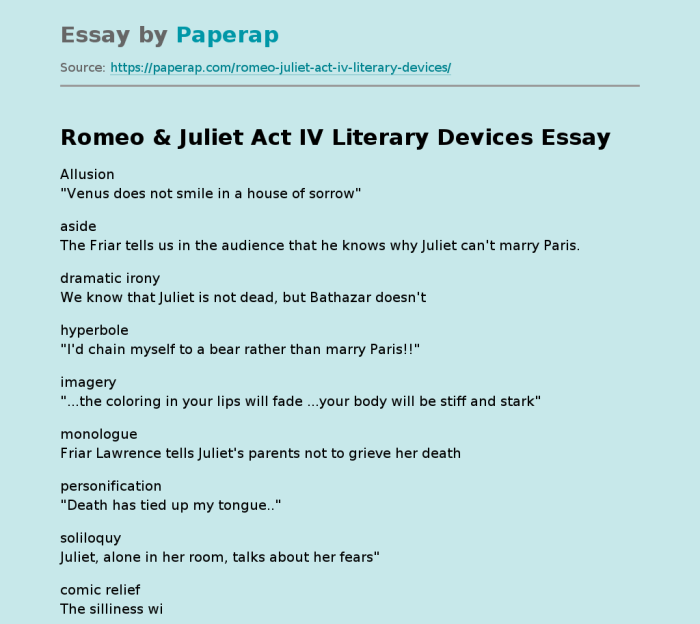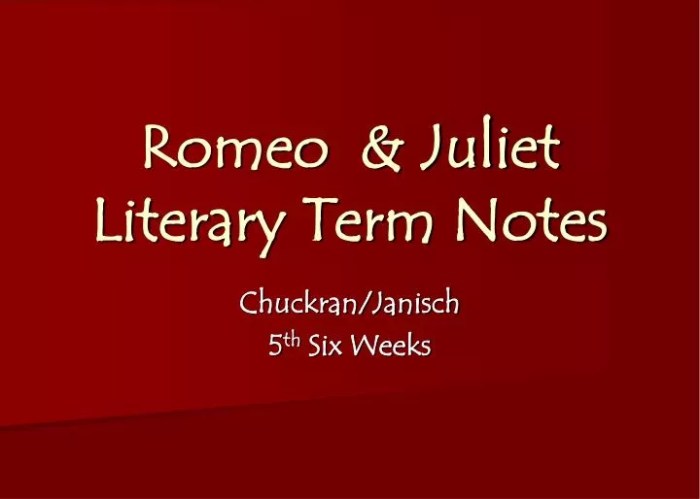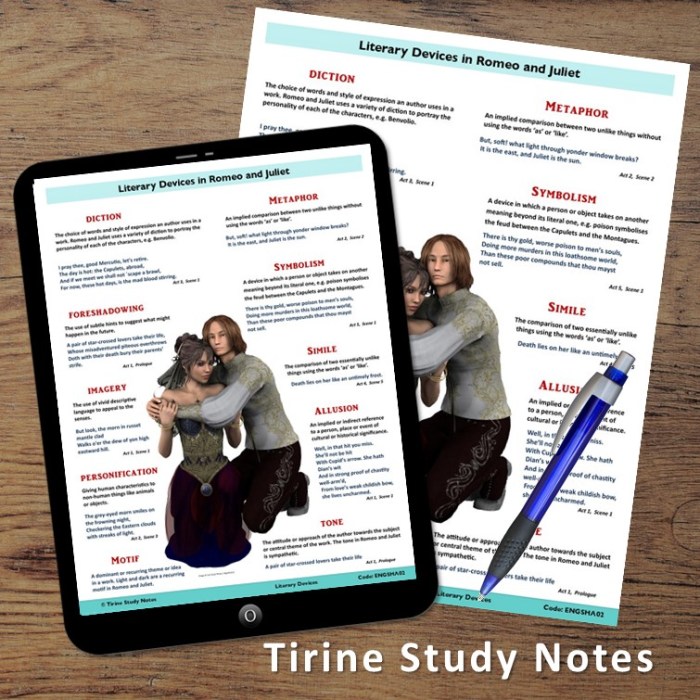Literary devices of romeo and juliet – Literary devices in Romeo and Juliet, a timeless masterpiece by William Shakespeare, serve as the scaffolding upon which the play’s profound themes and complex characters are constructed. These devices, employed with masterful precision, illuminate the play’s exploration of love, fate, and the human condition.
Through metaphors and similes, Shakespeare paints vivid pictures that evoke the characters’ innermost emotions and motivations. Foreshadowing techniques create an atmosphere of suspense and inevitability, propelling the audience towards the tragic climax. Irony, in its various forms, highlights the play’s central conflicts and the characters’ flawed perceptions.
Metaphor and Simile

Metaphors and similes are figures of speech that create vivid and imaginative comparisons. In Romeo and Juliet, Shakespeare uses these devices to convey complex emotions and ideas, and to enhance the play’s themes and characters.For example, in the famous balcony scene, Romeo compares Juliet to the sun: “But soft! What light through yonder window breaks? It is the east, and Juliet is the sun.”
This metaphor not only describes Juliet’s beauty but also suggests her transformative power, as she brings light into Romeo’s life.Another striking simile occurs when Romeo describes Juliet’s eyes as “two of the fairest stars in all the heaven.” This comparison emphasizes Juliet’s celestial beauty and her ability to inspire love and devotion.
Foreshadowing
Foreshadowing is a literary technique that hints at future events or outcomes, creating suspense and building tension. In Romeo and Juliet, Shakespeare uses foreshadowing to create a sense of inevitability and to suggest the tragic fate that awaits the young lovers.For
instance, in the prologue, the Chorus declares, “Two households, both alike in dignity, In fair Verona, where we lay our scene, From ancient grudge break to new mutiny, Where civil blood makes civil hands unclean.” This foreshadowing establishes the conflict between the Montagues and Capulets and suggests that it will lead to violence and bloodshed.Another
example of foreshadowing occurs when Friar Laurence warns Romeo about the dangers of love: “These violent delights have violent ends, And in their triumph die, like fire and powder, Which, as they kiss, consume.” This foreshadowing suggests that Romeo and Juliet’s passionate love will ultimately lead to their downfall.
Irony
Irony is a literary device that creates a contrast between what is expected and what actually happens. In Romeo and Juliet, Shakespeare uses irony to highlight the play’s tragic themes and to emphasize the characters’ flaws and mistakes.For example, there is dramatic irony when the audience knows that Romeo believes Juliet to be dead, while she is actually alive.
This irony creates suspense and builds tension, as the audience anticipates the tragic outcome that Romeo does not yet know.Another example of irony occurs when Friar Laurence’s plan to help Romeo and Juliet elope goes awry, leading to their deaths.
This situational irony highlights the characters’ lack of control over their own lives and the inevitability of fate.
Imagery, Literary devices of romeo and juliet
Imagery refers to the use of sensory details to create vivid and evocative descriptions. In Romeo and Juliet, Shakespeare uses imagery to enhance the play’s atmosphere and mood, and to convey the characters’ emotions and experiences.For example, Shakespeare uses visual imagery to create a vivid picture of the lovers’ first meeting: “Did my heart love till now? For I ne’er saw true beauty till this night.”
This imagery not only describes Juliet’s physical beauty but also suggests the transformative power of love.Another example of imagery occurs when Romeo describes the night sky as “a canopy spread over our heads, With a thousand twinkling stars.” This auditory imagery creates a sense of wonder and awe, and emphasizes the romantic atmosphere of the lovers’ meeting.
Helpful Answers: Literary Devices Of Romeo And Juliet
What is the significance of metaphors and similes in Romeo and Juliet?
Metaphors and similes contribute to the play’s vivid imagery and emotional depth by comparing characters and situations to familiar objects and experiences.
How does foreshadowing contribute to the play’s tragic impact?
Foreshadowing techniques create a sense of impending doom and heighten the audience’s anticipation of the tragic events to come.
What are the different types of irony used in Romeo and Juliet?
The play employs situational, dramatic, and verbal irony to highlight the characters’ flawed perceptions, misunderstandings, and the gap between appearance and reality.

